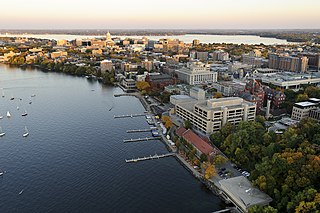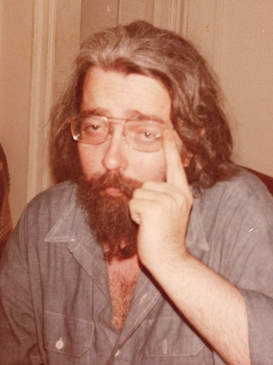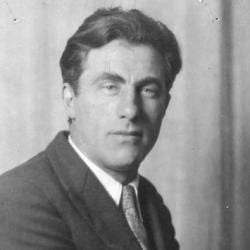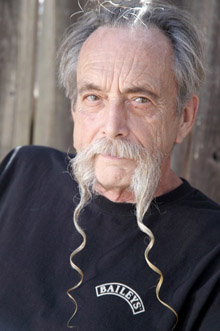
Madison is the capital city of the U.S. state of Wisconsin and the seat of Dane County. The population was 269,840 as of the 2020 census, making it the second-most populous city in Wisconsin, after Milwaukee, and the 77th-most populous in the United States. The Madison metropolitan area had a population of 680,796. The city is located on an isthmus and lands surrounding five lakes—Lake Mendota, Lake Monona, Lake Wingra, Lake Kegonsa and Lake Waubesa. Madison was founded in 1836 and is named after American Founding Father and President James Madison.

Peter Lamborn Wilson was an American anarchist author and poet, primarily known for his concept of Temporary Autonomous Zones, short-lived spaces which elude formal structures of control. During the 1970s, Wilson lived in the Middle East and worked at the Imperial Iranian Academy of Philosophy under the guidance of Iranian philosopher Seyyed Hossein Nasr, where he explored mysticism and translated Persian texts. Starting from the 1980s he wrote numerous political writings under the pen name of Hakim Bey, illustrating his theory of "ontological anarchy".
John Wilde was a painter, draughtsman and printmaker of fantastic imagery. Born near Milwaukee, Wilde lived most of his life in Wisconsin, save for service in the U.S. Army during World War II. He received bachelor and master degrees in art from the University of Wisconsin–Madison, where he taught for some 35 years. Wilde was associated with the Magic Realism movement and Surrealism in the United States. His darkly humorous figurative imagery often included self-portraits through which he interacted with the people, animals and surreal objects that populate his fantasy world.

Harry Gottlieb was an American painter, screen printer, lithographer, and educator.

Elizabeth Murray was an American painter, printmaker and draughtsman. Her works are in many major public collections, including those of the Solomon R. Guggenheim Museum, the Hirshhorn Museum and Sculpture Garden, the Pérez Art Museum Miami, the Museum of Modern Art, the Whitney Museum of American Art, the San Francisco Museum of Modern Art, the Art Institute of Chicago, the Carnegie Museum of Art, and the Wadsworth Atheneum. Murray was known for her use of shaped canvases.
Dawoud Bey is an American photographer, artist and educator known for his large-scale art photography and street photography portraits, including American adolescents in relation to their community, and other often marginalized subjects. In 2017, Bey was named a fellow and the recipient of a MacArthur Fellowship from the John D. and Catherine T. MacArthur Foundation and is regarded as one of the "most innovative and influential photographers of his generation".

William Thomas Wiley was an American artist. His work spanned a broad range of media including drawing, painting, sculpture, film, performance, and pinball. At least some of Wiley's work has been referred to as funk art.
Michelle Grabner is an artist, curator, and critic based in Wisconsin. She is the Crown Family Professor of Art at the School of the Art Institute of Chicago where she has taught since 1996. She has curated several important exhibitions, including the 2014 Whitney Biennial at the Whitney Museum of American Art along with Anthony Elms and Stuart Comer, and FRONT International, the 2016 Portland Biennial at the Oregon Contemporary, a triennial exhibition in Cleveland, Ohio in 2018. In 2014, Grabner was named one of the 100 most powerful women in art and in 2019, she was named a 2019 National Academy of Design's Academician, a lifetime honor. In 2021, Grabner was named a Guggenheim Fellow by The John Simon Guggenheim Memorial Foundation.
James Castle was an American artist born in Garden Valley, Idaho. Although Castle did not know about the art world outside of his small community, his work ran parallel to the development of 20th-century art history. His works have been collected by major institutions. The Philadelphia Museum of Art organized a retrospective of Castle's work which toured nationally in 2008–09. Castle's work entered the international arena with a substantial exhibition in Madrid, Spain at the Museo Nacional Centro de Arte Reina Sofía in 2011 and was included in the 2013 Venice Biennale exhibition The Encyclopedic Palace. In 2014 The Smithsonian American Art Museum featured their recent acquisition in the exhibition Untitled: The Art of James Castle and the Whitney Museum of American Art included their acquired collection of Castle's work in the 2017 exhibition Where We Are.

The University of Wisconsin–Madison is a public land-grant research university in Madison, Wisconsin, United States. Founded when Wisconsin achieved statehood in 1848, UW–Madison is the official state university of Wisconsin and the flagship campus of the University of Wisconsin System. It was the first public university established in Wisconsin and remains the oldest and largest public university in the state. UW–Madison became a land-grant institution in 1866. The 933-acre (378 ha) main campus, located on the shores of Lake Mendota, includes four National Historic Landmarks. The university also owns and operates the 1,200-acre (486 ha) University of Wisconsin–Madison Arboretum, located 4 miles (6.4 km) south of the main campus, which is also a National Historic Landmark.

Fred Fenster is a metalsmith and professor emeritus of the University of Wisconsin at Madison where he taught art and education. He is particularly known for his work in pewter, influencing generations of metalsmiths. Fenster was named a Fellow of the American Craft Council in 1995.
Lester Johnson was an American artist and educator. Johnson was a member of the Second Generation of the New York School during the late 1950s. The subject of much of his work is the human figure. His style is considered by critics and art historians to be in the figurative expressionist mode.
Evan Gruzis is a contemporary artist born in 1979 in Milwaukee, Wisconsin, United States. He has lived and worked in Los Angeles and New York City, and, since 2012, has lived in Wisconsin with his partner, Nicole Rogers, and their child. Gruzis first became known for his vivid paintings, which have been described as "extremely flat sculptures." His work also includes elaborate installations as well as collaborations which blur the lines of curation and production. In addition to his artistic practice, Gruzis owns and operates The Heights, a collaborative restaurant in Madison, Wisconsin, and teaches painting and drawing at the School of the Art Institute of Chicago.

Clayton George Bailey, was an American artist who worked primarily in the mediums of ceramic and metal sculpture.
Dyani White Hawk is a contemporary artist and curator of Sicangu Lakota, German, and Welsh ancestry based out of Minnesota. From 2010 to 2015, White Hawk was a curator for the Minneapolis gallery All My Relations. As an artist, White Hawk's work aesthetic is characterized by a combination of modern abstract painting and traditional Lakota art. White Hawk's pieces reflect both her Western, American upbringing and her indigenous ancestors mediums and modes for creating visual art.
Linda Threadgill is an American artist whose primary emphasis is metalsmithing. Her metal work is inspired by forms of nature and the interpretations she gleans from the intricate patterns it presents. She explores the foundation of nature to allude to nature and transform it into re-imagined, stylized plants forms.
K.S. (Kathy) Ernst is an American poet and artist best known for her work in visual poetry and three-dimensional object poems. While she has created over 500 physical works, she works extensively in digital art as well. Although born in St. Louis, she has spent most of her life in New Jersey, where her current studio is.
Joel S. Cohen is an American graphic artist and cofounder, along with Diane E. Milder, of Ragged Edge Press, an independent offset printing company in New York City. Principally recognized for his creative mail art projects and artistic collaborations with Thomas Kerr and Kurt Vonnegut, Cohen has been creating, printing, and distributing progressive political art since the early 1970s.

Alfred A. Sessler (1909–1963) was an American artist known for his murals for the Works Progress Administration (WPA), his printmaking, and his career as a teacher.









